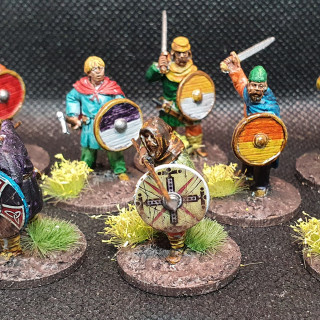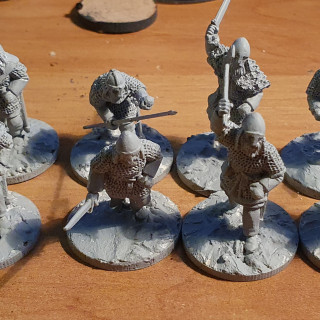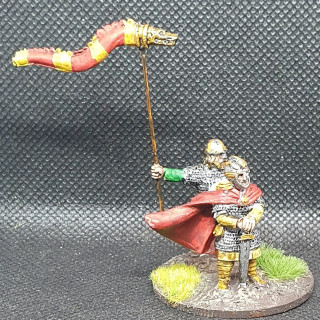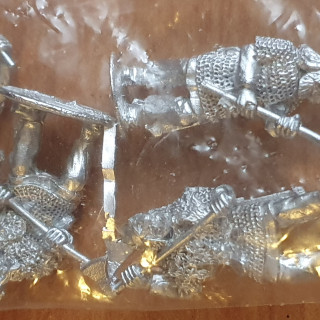
Saga Vikings and Saxons
Recommendations: 316
About the Project
Words and stuff
Related Game: SAGA
Related Company: Footsore Miniatures and Games
Related Genre: Historical
This Project is Active
A word of thanks
I would like to thank the following people , for the help and advice they have given me on this Project
@MandaPii
@panzerkaput
@avernos
and of course @sundance for the encouragement to make me work faster 😉
Week 1 update
Vikings
In 793 came the first recorded Viking raid, where ‘on the Ides of June the harrying of the heathen destroyed God’s church on Lindisfarne, bringing ruin and slaughter’ (The Anglo-Saxon Chronicle).
These ruthless pirates continued to make regular raids around the coasts of England, looting treasure and other goods, and capturing people as slaves. Monasteries were often targeted, for their precious silver or gold chalices, plates, bowls and crucifixes.
Gradually, the Viking raiders began to stay, first in winter camps, then settling in land they had seized, mainly in the east and north of England.
Outside Anglo-Saxon England, to the north of Britain, the Vikings took over and settled Iceland, the Faroes and Orkney, becoming farmers and fishermen, and sometimes going on summer trading or raiding voyages. Orkney became powerful, and from there the Earls of Orkney ruled most of Scotland. To this day, especially on the north-east coast, many Scots still bear Viking names.
To the west of Britain, the Isle of Man became a Viking kingdom. The island still has its Tynwald, or ting-vollr (assembly field), a reminder of Viking rule. In Ireland, the Vikings raided around the coasts and up the rivers. They founded the cities of Dublin, Cork and Limerick as Viking strongholds.
Meanwhile, back in England, the Vikings took over Northumbria, East Anglia and parts of Mercia. In 866 they captured modern York (Viking name: Jorvik) and made it their capital. They continued to press south and west. The kings of Mercia and Wessex resisted as best they could, but with little success until the time of Alfred of Wessex, the only king of England to be called ‘the Great’.
https://www.history.org.uk/primary/resource/3867/the-vikings-in-britain-a-brief-history
Saxon
Anglo-Saxon England was early medieval England, existing from the 5th to the 11th centuries from the end of Roman Britain until the Norman conquest in 1066. It consisted of various Anglo-Saxon kingdoms until 927 when it was united as the Kingdom of England by King Æthelstan (r. 927–939). It became part of the short-lived North Sea Empire of Cnut the Great, a personal union between England, Denmark and Norway in the 11th century.
https://en.wikipedia.org/wiki/History_of_Anglo-Saxon_England
The Blood Eagle
The blood eagle is a ritual method of execution, detailed in late skaldic poetry. According to the two instances mentioned in the Sagas, the victims (in both cases members of royal families) were placed in a prone position, their ribs severed from the spine with a sharp tool, and their lungs pulled through the opening to create a pair of “wings”. There is continuing debate about whether the rite was a literary invention, a mistranslation of the original texts, or an authentic historic practice.
The blood-eagle ritual-killing rite appears in just two instances in Norse literature, plus oblique references some have interpreted as referring to the same practice. The primary versions share certain commonalities: the victims are both noblemen (Halfdan Haaleg or “Long-leg” was a prince; Ælla of Northumbria a king), and both of the executions were in retaliation for the murder of a father.
alfred the great
Alfred the Great (849-899) was the most famous of the Anglo-Saxon kings. Despite overwhelming odds he successfully defended his kingdom, Wessex, against the Vikings. He also introduced wide-ranging reforms including defence measures, reform of the law and of coinage.
He was a keen champion of education and translated important texts from Latin into English.
Known as a just and fair ruler, Alfred is the only English King to have earned the title ‘the Great’.
Facts:
- Alfred was born in 849 at the royal palace in Wantage. He became king in 871 and died in 899.
- He had four older brothers who all ruled as king before he did.
- As a boy of four he accompanied his father Aethelwulf on a pilgrimage to Rome.
- By 870 Northumberland, East Anglia and Mercia has all fallen to the Vikings. Wessex was the only Anglo-Saxon kingdom to hold out against the Vikings.
- In 870 Alfred and his brother Aethelred fought nine battles against the Vikings.
- In 879 Alfred won a decisive victory against the Vikings at Edington.
- After defeating Guthrum the Dane, Alfred made him convert to Christianity and then adopted Guthrum as his foster son.
- In 886 he recaptured London and set about renovating the city.
- Alfred’s fortified towns or burhs formed the basis of the English system of boroughs and shires.
- Alfred believed that all free born English boys should receive an education and he set up a school at his court to educate his sons, as well as those of the nobles and others of lesser birth.





















































































































